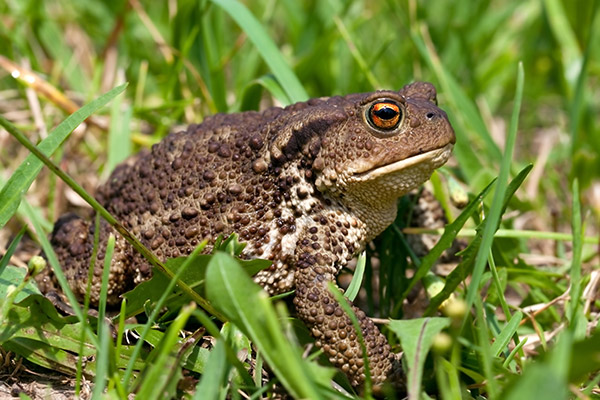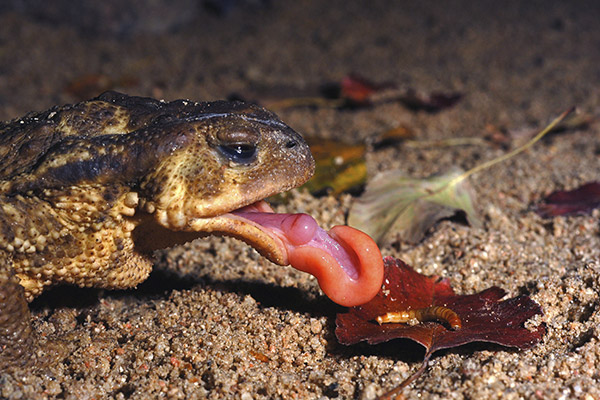binomial nomenclature
common name
Bufo bufo
Toad
It’s the largest native amphibian in Europe. In particular, the toad belongs to the order Anura, that is, without the tail; it has a stocky and strong body, of colour varying from dark brown to dark red, or yellowish grey. The skin is dry and covered with small warts.

What do they need these warts for?
They are glands that secrete a kind of protective mucus that the toad uses to keep his skin moist, thus protecting it from dehydration.
If it feels at risk, from the glands placed behind the eyes (called paratoid), it produces a toxic substance called bufotoxin, dangerous if it comes into contact with the mucous membranes. What it means? If a predator like the grass snake, bites the toad, its mouth will come into contact with this toxic substance. So, it’s nothing more than a toad’s defensive weapon!
Remember: the bufotoxin is not dangerous to the touch, so if you touch a toad, nothing will happen; the important thing is not to touch your eyes, because they might get irritated and burn. The basic rule, however, is not to touch the toad and amphibians with your bare hands, because you could be a vehicle of some pathology. The skin is a particularly essential organ for the amphibians, they also use it to breathe!
The eyes of this amphibian are big, little protruding, and of copper, orange, dark gold or reddish-brown colour. The horizontal pupils are especially specialized for the night and downward view, considering that the search for the prey takes place mainly on the ground.
What do they feed on?
Insects, worms, isopods, arachnids and snails.
It holds the tongue bent at the front of the lower jaw, then quickly push it outwards when capturing an animal. The prey remains taped to the sticky tongue, then is carried in the mouth and swallowed whole.
Habitat
The toad can be found in woods, cultivated fields, meadows, vegetable gardens and lawns. It lives in wet places such as lakes, rivers, ponds and moats, only during the periods of the reproduction, coupling and deposition of the eggs, but only if the waters characterizing them are steady or slow-flowing, and not too deep.
Moving mainly at night, it spends the daytime under stones, in the rocky crevices or in dens dug in the ground with the strong forelegs; it is not unusual, however, to see it move during the day when it rains.

Other information about the toad
When attacked, the common toad adopts a characteristic stance, inflating its body and standing with its hindquarters raised and its head lowered.
It’s habitual, it tends to go back to the same breeding site every year. In the first warm days, towards the end of the winter, the toads begin to move from the hibernation sites up to the reproduction places, making a sort of mass migration. They are able to travel up to 2 km to get to the chosen wetland! Unfortunately, they need to cross very busy roads, risking of being run over. The female lays a long gelatinous string which may contain 3000 to 6000 eggs.
A tricky situation
The toad and generally all the amphibians, are at the present day, still strongly under threat and steadily decreasing, mainly due to the slow destruction that are suffering their habitats, mostly the aquatic ones where they reproduce.